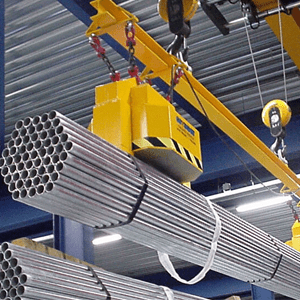All crane lifting jobs require a plan for the proper rigging of loads. Many times this can be the hardest part of the project. Harriman Material Handling can help by designing a custom lifter or spreader bar to pick up your specific part.

Spreader bars, like the one shown above, help balance loads and minimize sway. Harriman’s engineering design department can help your company create a lifting device for your specific application. We also have the capability to design devices with special applications that provide ergonomic solutions, such as parts movement in assembly workstations.

Lift Magnets
Understanding points of failure are key with lift magnets – they cannot be visually inspected alone. Lift magnet failure is often the result of internal damage to the magnetic material and is not evident by simple visual inspections that can be performed on other lifting devices.
Proper breakaway testing of a lift magnet will determine the maximum lift capacity of that magnet under ideal conditions. The outcome of the test allows the operator/owner of the lift to determine if the magnet meets the rated Working Load Limit (WLL) or lift capacity as designed by the manufacturer.
Common Factors For Lift Magnet Loss Of Performance Or Failure
1. Blunt force impact such as dropping, or banging on, the magnet can cause fractures in the magnet
2. High heat: If the magnet is exposed to temperatures above its’ capabilities it will lose magnetism
3. Exposure to electrical fields, like generators or welding ground circuits, will result in loss of magnetism.
4. External factors that influence a lift magnet’s performance are; nicks, scratches, gouges, rust, etc. to the contact surface of the lifter.
When’s the last time you had a proper break away test performed on your magnetic lifters? Give us a call to schedule a load test (765) 763-8959.

The Crucial Role of Servicing Your Equipment
/in Services, Workplace SafetyEverything You Need to Know About Fixed Ladder Fall Protection
/in Products, Workplace SafetyInspire Inclusion: IWD 2024
/in Community, Diversity and InclusionUnderstanding the Importance of Overhead Crane Runways
/in Products, Services, Workplace SafetyCelebrating Excellence: Harriman Material Handling Receives Prestigious Award from Gorbel
/in News7 Ways Your Company Can Make Fall Protection a Top Priority
/in Workplace SafetyOptimizing Production Capacity: A Customized Super Structure with Gorbel Cranes
/in Case StudyAssembling a Genset Lifter for an Engine Manufacturer
/in Case StudyBringing Safety & Efficiency to Unbalanced Loads with Lifting Devices
/in UncategorizedAll crane lifting jobs require a plan for the proper rigging of loads. Many times this can be the hardest part of the project. Harriman Material Handling can help by designing a custom lifter or spreader bar to pick up your specific part.
Spreader bars, like the one shown above, help balance loads and minimize sway. Harriman’s engineering design department can help your company create a lifting device for your specific application. We also have the capability to design devices with special applications that provide ergonomic solutions, such as parts movement in assembly workstations.
Lift Magnets
Understanding points of failure are key with lift magnets – they cannot be visually inspected alone. Lift magnet failure is often the result of internal damage to the magnetic material and is not evident by simple visual inspections that can be performed on other lifting devices.
Proper breakaway testing of a lift magnet will determine the maximum lift capacity of that magnet under ideal conditions. The outcome of the test allows the operator/owner of the lift to determine if the magnet meets the rated Working Load Limit (WLL) or lift capacity as designed by the manufacturer.
Common Factors For Lift Magnet Loss Of Performance Or Failure
1. Blunt force impact such as dropping, or banging on, the magnet can cause fractures in the magnet
2. High heat: If the magnet is exposed to temperatures above its’ capabilities it will lose magnetism
3. Exposure to electrical fields, like generators or welding ground circuits, will result in loss of magnetism.
4. External factors that influence a lift magnet’s performance are; nicks, scratches, gouges, rust, etc. to the contact surface of the lifter.
When’s the last time you had a proper break away test performed on your magnetic lifters? Give us a call to schedule a load test (765) 763-8959.
Scaling Trailer Manufacturing with Telescoping Cranes
/in Case Study, Products